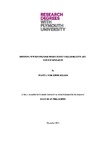Defining new knowledge produced by collaborative art-science research
| dc.contributor.supervisor | Scott, Jillian | |
| dc.contributor.author | Schlaepfer-Miller, Juanita | |
| dc.contributor.other | Faculty of Arts, Humanities and Business | en_US |
| dc.date.accessioned | 2016-10-12T10:11:14Z | |
| dc.date.available | 2016-10-12T10:11:14Z | |
| dc.date.issued | 2016 | |
| dc.identifier | 10253558 | en_US |
| dc.identifier.uri | http://hdl.handle.net/10026.1/6500 | |
| dc.description.abstract |
This thesis takes a theoretical framework constructed for transdisciplinary research within different natural science disciplines and investigates what kind of new knowledge is produced when this framework is applied to projects at the interface of art and natural science. The main case study is “Sauti ya Wakulima – The Voice of the Farmers”, which involves collaboration with another intervention artist, and with natural scientists and farmers. This is a collaborative knowledge project with small-scale urban as well as rural farmers in Tanzania who have created an online community archive of their farming practices by using mobile phones to upload images and sounds onto a website. The research uses an open-ended participatory methodology that gives the participants as much creative agency as possible within the given power structures and practical and technical parameters. A second work examined is the Climate Hope Garden, an installation by the author in collaboration with ecologists and climate scientists at the Swiss Federal Institute of Technology, Zürich (ETHZ). The installation consisted of a garden grown in climate-controlled chambers based on the climatic conditions proposed by IPCC climate scenarios. The project aimed to enact these scenarios on a spatial and temporal scale to which visitors could relate. Transdisciplinary research has become a key reference point in funding proposals. Despite many references in the literature, and calls for research involving both the natural sciences and humanities to solve complex world problems such as adaptation to climate change, there seems to be little consensus about exactly what kind of knowledge might be produced from such projects, and how transdisciplinary research proposals might be evaluated, especially those at the interface of art and the natural sciences. Several theoretical frameworks have been suggested for designing transdisciplinary research between and within scientific disciplines, or between the natural and social sciences and humanities. The present study applies the framework proposed by Christian Pohl and Gertrude Hirsch Hadorn (2007) to a real-world transdisciplinary art-science project in a development context in order to examine the balance between the collective, locally embodied experience and the nomothetic knowledge that arises from it. This thesis found that transdisciplinarity is a different question from that of types of knowledge on the nomothetic-idiographic scale. Transdisciplinarity is a pragmatic question of definitions and inherited boundaries of disciplines. The framework categories do not differentiate between nomothetic and idiographic, just to which part of the problem-solving puzzle they fit. This is perfectly valid for goal-oriented, problem-solving research and can be applied to art-science research, but there are other ways of describing this work, such as using a philosophical description of the knowing process which comes closer to encompassing the richness of the knowledge produced. It is in this sense that the new type of knowledge generated by the transdisciplinary projects required an expansion of the given theoretical framework. | en_US |
| dc.language.iso | en | en_US |
| dc.publisher | Plymouth University | en_US |
| dc.subject | Art-science | en_US |
| dc.subject | Transdisciplinary Research | |
| dc.subject | Collaboration, between Artists and Scientists | |
| dc.title | Defining new knowledge produced by collaborative art-science research | en_US |
| dc.type | Thesis | |
| plymouth.version | Full version | en_US |
| dc.identifier.doi | http://dx.doi.org/10.24382/4395 |
Files in this item
This item appears in the following Collection(s)
-
01 Research Theses Main Collection
Research Theses Main


